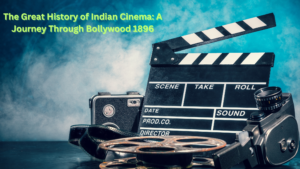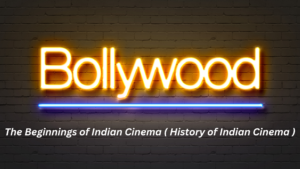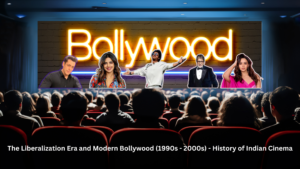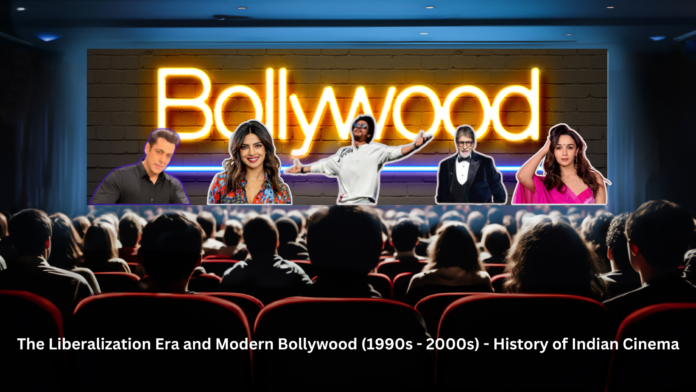The Great History of Indian Cinema A Journey Through Bollywood 1896
Indian cinema, often referred to as “Bollywood,” has grown into one of the largest film industries in the world. Known for its vibrant storytelling, colorful song-and-dance sequences, and dramatic flair, Bollywood has become synonymous with Indian culture and entertainment. This article takes you through the fascinating history of Bollywood, from its early beginnings to its evolution into a global powerhouse.

The Beginnings of Indian Cinema ( History of Indian Cinema )
The roots of Bollywood can be traced back to the late 19th century when the Lumière brothers’ cinematograph was first shown in Bombay (now Mumbai) in 1896. Inspired by the magic of moving pictures, Indian filmmakers began experimenting with this new medium. The first Indian film, *Raja Harishchandra*, was directed by Dadasaheb Phalke in 1913. It was a silent film based on a mythological story, and its success marked the birth of Indian cinema.
Dada Saheb Phalke, often called the “father of Indian cinema,” went on to make more than 90 films, setting the stage for what would become a booming film industry. His efforts paved the way for other filmmakers, and soon, Indian audiences were captivated by this new form of storytelling.
History of Indian Cinema :- The Silent Era (1910s – 1930s)
During History of Indian Cinema the silent film era, Indian cinema focused primarily on mythological and historical themes, drawing inspiration from traditional Indian epics like the *Ramayana* and *Mahabharata*. Filmmakers experimented with different storytelling techniques, but they faced challenges due to the lack of sound technology. Despite these limitations, Indian cinema continued to grow, and by the 1920s, dozens of films were being produced annually.

The lack of sound did not deter audiences, who flocked to theaters to watch these films. The visuals, combined with live musicians performing in cinemas, helped create an immersive experience. By the end of the 1920s, Indian cinema was well-established, and filmmakers eagerly awaited the arrival of sound technology.
The Advent of Sound: Talkies and the Rise of Bollywood (1930s – 1940s)
The arrival of sound technology in the 1930s transformed Indian cinema. “Alam Ara“, released in 1931, was India’s first talkie film, directed by Ardeshir Irani. It was an instant success, and the use of sound opened up new possibilities for storytelling. Songs became an integral part of Indian cinema, setting Bollywood apart from its counterparts in the West. Musical narratives began to dominate, and songs often became as iconic as the films themselves.
The 1930s and 1940s saw the rise of social films that addressed pressing issues like caste discrimination, poverty, and women’s rights. Filmmakers like V. Shantaram and Bimal Roy emerged as pioneers, blending entertainment with social messages. Bollywood’s identity as a medium that could entertain, educate, and inspire was firmly established during this period.
History of Indian Cinema :- The Golden Era of Bollywood (1950s – 1960s)
The 1950s and 1960s are often referred to as the Golden Era of Bollywood, a time when Indian cinema flourished in both artistic and commercial terms. Iconic filmmakers like Raj Kapoor, Guru Dutt, and Mehboob Khan created timeless classics that continue to be celebrated. Films such as *Mother India* (1957), *Pyaasa* (1957), and *Shree 420* (1955) dealt with themes of love, sacrifice, and social justice, resonating with audiences across the nation.
During this period, Bollywood also saw the emergence of legendary actors like Dilip Kumar, Dev Anand, and Raj Kapoor, who became household names. The music of this era, composed by maestros like R.D. Burman and Lata Mangeshkar, became a vital part of Indian culture, with songs often outlasting the popularity of the films themselves.
The Era of Masala Films (1970s – 1980s) – History of Indian Cinema
The 1970s marked a shift in Bollywood’s style, giving rise to the “masala film” genre. Masala films combined action, romance, comedy, and drama, often featuring larger-than-life heroes and melodramatic plotlines. Amitabh Bachchan, known as the “Angry Young Man,” emerged as a superstar with films like *Sholay* (1975), *Deewar* (1975), and *Zanjeer* (1973). These movies struck a chord with audiences, reflecting the socio-political struggles of the time.
Directors like Manmohan Desai and Prakash Mehra became synonymous with this new wave of commercial cinema. Their films were characterized by vibrant storytelling, memorable dialogues, and unforgettable songs, which solidified Bollywood’s reputation as a source of pure entertainment. This era also saw the expansion of Bollywood’s reach, as Indian communities around the world embraced these films, creating a global fanbase.
The Liberalization Era and Modern Bollywood (1990s – 2000s) – History of Indian Cinema
The economic liberalization of India in the 1990s had a profound impact on Bollywood. As the country opened up to the global market, Bollywood films began to incorporate international influences, blending Western and Indian elements. The 1990s saw the rise of a new generation of stars, including Shah Rukh Khan, Aamir Khan, and Salman Khan, whose romantic and action-packed films attracted massive audiences.
Romantic dramas like “Dilwale Dulhania Le Jayenge” (1995) and Kuch Kuch Hota Hai (1998) became iconic, not only in India but also among the Indian diaspora worldwide. These films established Bollywood as a global phenomenon, and stars like Shah Rukh Khan became internationally recognized. The introduction of multiplexes and modernized film studios also contributed to a shift in Bollywood’s approach, as filmmakers began experimenting with new genres and narratives.

The Rise of New Bollywood (2010s – Present) – History of Indian Cinema
The 21st century has witnessed the evolution of “New Bollywood,” a term used to describe the industry’s shift towards diverse storytelling and high production values. Modern Bollywood combines traditional elements with contemporary themes, addressing social issues while exploring genres like biopics, thrillers, and historical dramas.
Directors like Rajkumar Hirani, Sanjay Leela Bhansali, and Zoya Akhtar have crafted visually stunning and critically acclaimed films. Movies like 3 Idiots (2009), *Bajirao Mastani* (2015), and *Gully Boy* (2019) reflect the changing tastes of audiences, who now seek meaningful content alongside entertainment.
Bollywood’s influence has expanded globally, with Indian films being showcased at international film festivals like Cannes and Toronto. Streaming platforms such as Netflix and Amazon Prime have also played a crucial role in making Bollywood films accessible to a wider audience, breaking language and cultural barriers.
History of Indian Cinema – Bollywood’s Global Impact
Today, Bollywood is not just an Indian phenomenon; it is a global brand. The industry produces over 1,000 films a year, making it one of the largest film industries in the world. Bollywood stars enjoy international fame, and Indian cinema has become a vital cultural export. The colorful, music-filled narratives of Bollywood continue to captivate audiences across continents, making it a unique and enduring symbol of Indian culture.
Thanks And Regards




Informative post